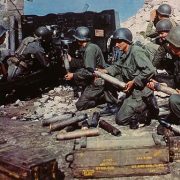Jagdpanther Heavy Tank Destroyer






Argentina's Model 1968 RCL is a recoilless gun that can fire 4.13 inch (105mm) high explosive (HE) rounds to an effective maximum range of 10,000 yards (9200m).
The effective range for High Explosive Anti-Tank (HEAT) rounds is about 1300 yards (1200m).
With a muzzle velocity of 1312f/s (400m/s), the Model 1968's hollow charge round can penetrate

The Pak 41 was a Gerlich gun - one of a series of anti-tank guns with tapered bores. Dr. Gerlich, a ballistics expert at Krupps, developed the tapered design of the Gerlich gun, which was unique for guns of its time.
The barrel of the Pak 41consisted of a 75 mm rifled bore that tapered
In 1939, Germany began working on the development of a 75mm anti-tank gun to counter predicted increases in armor thickness. Rheinmetalls's design of the 7.5 cm Pak 40 was accepted by the Germans in 1940. Production of the Pak 40 anti-tank gun began in 1942.
The Pak 40 was essentially a larger version of the

The 57mm Gun M1, which was produced in the United States from 1942 to 1945, was the American version of the British 6 Pounder anti-tank gun.
Because of production differences between the two countries, there were differences between the M1 and the 6 Pounder.
The M1 had a slightly longer barrel than the 6 Pounder.

The Soviet Union developed the ZiS-2 Model 1941 anti-tank gun in anticipation of an increase in tank armor on the battlefield. It used a 3inch (76.2mm) cartridge, which was necked down to fire a 2.24inch (57mm) round.
A BC-271M round, when fired from the Zis-2 Model 1941, had a muzzle velocity of 3250ft/s (990m/s), enabling

The Soviet Union's Model 1942 anti-tank gun, also known as the M-1942, was an upgrade of earlier 45mm anti-tank guns.
The 2.7 inch (68.6mm) caliber barrel on the Model 1942 was longer than the gun barrels of earlier models.
The Model 1942 also had longer, more stable trail legs and steel disk wheels, and, unlike

Long before World War II began, the British realized they would need to replace their 2 pounder anti-tank gun with a more powerful weapon.
Design of the 6 pounder anti-tank gun commenced in 1938, and production began in 1941.
The 6 pounder took half as long to build as the 2 pounder, as the 6 pounder

The Pak 38 anti-tank gun was first produced in 1939. It was used as a self-propelled gun as well as an anti-tank gun.
Light alloys were used to create the gun carriage, making the Pak 38 easy to handle.
The Pak 38 had a tungsten-cored AP40 round that could penetrate 4.7inches (120mm) of armor at